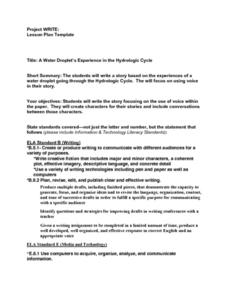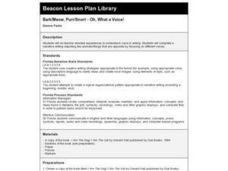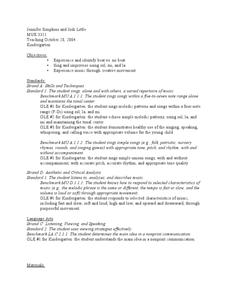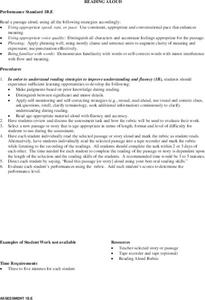Curated OER
Same Setting, Different Moods: Voice and Word Choice Using Lord of the Flies
Whether it's dark, delightful, or somber, set the mood with William Golding's Lord of the Flies. High-schoolers practice descriptive writing by creating the appropriate mood for an original scene, starring one of the book's main...
Curated OER
Style and Voice
Develop the writing skills of your high school class. Writers consider their personal style and voice, read selections by other authors, and then write pieces that challenge them to experiment with their own style.
Florida Alliance for Arts Education
Theatre Arts
What skills do storytellers employ to bring to life the characters and events in their tales? After listening to a recording of a Haitian folk tale, class members consider how tone of voice, pace, and gestures can be used to enliven a...
Curated OER
On the Road Again
Young scholars read to their peers from selected texts. As one person reads, the other person listens to his/her peer, noting tone and fluency. Afterward, they reflect on each other's reading. There is a guided reflection worksheet...
Curated OER
What's My Tone?
Students answer a question in the same tone of voice that you ask it in. In this tone lesson plan, students respond to the volume and expression of the teacher's voice.
Curated OER
Watch the Road Signs
What makes a good speaker? Upper elementary learners practice oral fluency by working with a partner to read nonfiction books. While reading, they practice using correct tone of voice, making eye contact, and speaking clearly.
Curated OER
Whose Voice Do I Hear?
Fifth graders examine the power of voice in writing by completing a story using words following a particular voice. They take simple nursery rhymes, then attempt to put their own voice to a revised version. An interesting lesson on writing!
Curated OER
Children's Playthings And Books
Students categorize studenT toys by intelligence types. They review toy safety and function and identify the appropriate play age of various toys. They read and evaluate studenT books and write one of their own.
Curated OER
Hello Girls
Ninth grade girls get together to sing the song Hello Girls. They warm up with common voice exercises then work to maintain melody, harmony, pitch and tone.
Curated OER
A Water Droplet's Experience in the Hydrologic Cycle
Students write a story from the perspective of a water droplet on a journey through the water cycle. They use the 6+1 Traits writing method to focus on voice in the writing as they create characters that their water droplet has...
Scholastic
Tell Us a Tale: Teaching Students to Be Storytellers
Encourage scholars to retell their favorite short story or folktale, adding personal details to make it their own. After reading their book of choice several times, story tellers retell a tale verbally to their classmates.
Curated OER
MTV's Poetry
Students use several strategies in poetry to convey tone and speaker. In this language arts lesson, students read and build vocabulary as they gain a larger understanding of how to write poetry. Students then work in groups in order...
Curated OER
My (musical) Valentine
Get out those bells, sand blocks, and sticks! Your kindergarteners use their singing voices to ask and answer friendly questions while keeping rhythm. They take turns in a group and in pairs singing questions and answers while keeping...
Curated OER
Communication, Day 2: Assertiveness
Having social skills and being able to assert yourself in a positive way is so important. Students with mild to moderate disabilities engage in a series of activities to practice assertive communication and social skills. Perfect for a...
King Country
Lesson 9: Communication - Day 2: Assertiveness
Appropriate assertive and non-verbal assertive communication is the focus of this lesson designed for the special education classroom. Using mirrors, class members practice assertive responses to a variety of situations.
Macmillan Education
Social Skills
Every culture has a set of social skills one must learn to establish and maintain relationships. Some of these skills are particular to a culture and some are universal. Class members practice using appropriate language,...
Curated OER
What Kind of Ladybug Are You?
As a class, read different sentences prepared by the teacher, identifying the punctuation that is needed for the appropriate expression. In small groups, have each child assume the role of one or more character in The Grouchy Ladybug by...
Curated OER
Bark, Meow, Purr, Snort - Oh, What a Voice!
Students brainstorm differences between dogs and cats. They discuss the elements that make a story effective and write a story with a beginning, middle and end in the voice of a cat or dog.
Curated OER
Say What? (A Murder Mystery)
Students practice their performance, expression, and logical thinking skills by asking questions and speaking in correct tones. They attempt to meet IEP requirements in these areas by presenting murder mystery clues using the appropriate...
Curated OER
We All Need Speed Limits
Pupils consider fluency and speed of reading. In this speed limits lesson, students discuss the importance of speed when reading and how the rate affects comprehension and listening skills. Teacher models think aloud as a strategy.
Curated OER
What's that Mammal?
Learning by example is always effective if it's paired with independent practice opportunities! Model good reading practices for your class. Learners listen to the teacher model examples of reading with voice, expression, and tone...
Curated OER
Singing: Mi, So, La
Little ones learn the tones mi, so, and la by singing an answer to a sung question. They play a name game to identify beat, then discuss songs with no beat. If there is time during this musical instruction instructional activity, they...
Curated OER
Singing: "I Mailed Myself to You"
Keeping a steady beat, singing soft, loud, and in unison - sounds like music class to me! First graders practice these skills while listening to the song, "I Mailed Myself to You" for Valentine's Day. This is a simple and age appropriate...
Curated OER
Reading Aloud
Reading aloud is a great way to engage learners in pacing and pronunciation! They practice using voice, pitch and intonation correctly. The teacher introduces the instructional activity by example, correctly stressing punctuation and...























